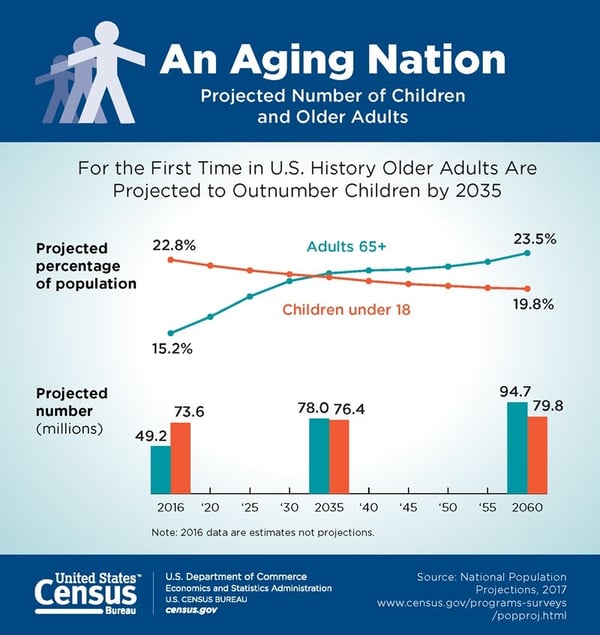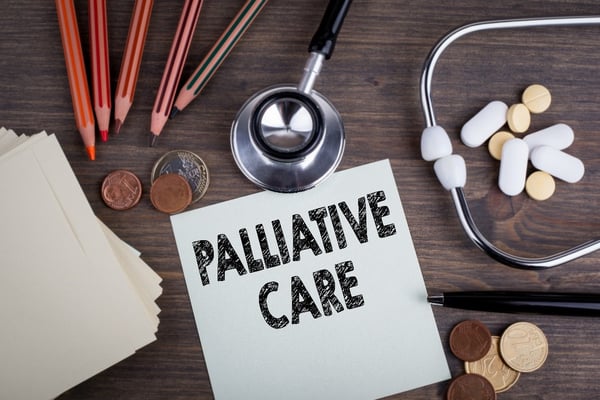Palliative care is an approach to specialized medical care for people with a serious illness that aims to prevent and relieve suffering, ultimately improving quality of life. As the world’s population has aged, the prevalence of serious and often life-threatening chronic conditions has risen exponentially. With this increase, the already limited supply of palliative care clinicians has been stretched thin in attempts to accommodate the growing need for palliative care providers and complex care planning.

Image Source: United States Census Bureau, 2018
Increasing Palliative Care Coordination with Telehealth
Duke researchers estimate that the palliative patient-to-physician ratio is 808 to 1, recently concluding that “if each patient was evaluated, on average, once every three months (in either a clinic or a hospital), each palliative care physician would need to perform 10 patient visits per day over 48 weeks to meet the current demand” (emphasis added). By utilizing telehealth, physicians, nurses (RN, NP, and CNS), additional clinicians, case managers, and social workers can provide palliative care virtually, outside of the brick-and-mortar clinic or traditional hospital setting.
Telehealth can serve as an invaluable tool for navigating the current healthcare climate, where access to skilled palliative providers is insufficient, and the prevalence of chronic conditions is rising. Palliative care is a specialty where an interdisciplinary approach has proved the most beneficial, and the potential for telehealth to aid in improving access to healthcare for more patients is evident.
Telehealth for palliative care, or “telepalliative care,” can encompass many things, including:
-
-
Video-based conferences between the provider, patient, and caregiver
-
Virtual case conferences with a patient, caregiver, palliative care provider, primary care clinician, or other necessary specialists
-
Self-reported assessment tools (e.g., symptom surveys and questionnaires)
-
Smartphone applications for the patient, caregiver, and provider
-
Remote activity monitoring and remote patient monitoring of symptoms
-
Education and medication management, including custom reminders for needed actions
-
A recent study in Western North Carolina examined the impact of telehealth on palliative care populations in rural communities. The study, which examined 101 palliative care patients with a mean age of 72 years found that remote patient monitoring resulted in improved symptom management. Three main advantages cited for this method of care were improved access to clinicians, quick clinician response, and improved efficiency and quality of care.
Home-Based Palliative Video Visits
Video visits between patient and clinician are proven to be both viable and acceptable by clinicians and patients in a variety of patient populations. Current evidence shows clear promise for the palliative care population. For many palliative care patients, getting to a hospital or clinic is immensely challenging due to extensive functional limitations and debilitating symptom burdens. Video visits offer an opportunity to replace or augment in-person visits, providing patients with continuity in their care while maintaining communication to address urgent concerns if they arise.
A recent systematic review of 39 articles on the use of video consultations in palliative care determined that video technology is feasible in palliative care and can be used for communication between providers, patients, and caregivers as well as for symptom control and clinical assessment of patients. The review included qualitative, quantitative, and mixed-method studies focusing on specialized palliative care in high-income countries and. While many of the studies focused on cancer patients, there were five that focused on video visits for non-cancer patients. These studies found that video consultations are a sensible option for non-cancer palliative patients, i.e., patients with diseases such as COPD, CHF, kidney failure, or stroke.
With video visits, the palliative interdisciplinary team can remain involved throughout the care plan, looping in the caregiver and specialists as needed. The patient can stay at home while still receiving quality care and symptom management from their personal team. Utilizing the virtual aspect of video visits in telepalliative health also eases the burden of traveling for both provider and caregiver.
For the palliative patient population, unnecessary emergency department visits are a major concern. With telehealth video conferencing available 24/7, many of these visits can be avoided, as the patient is able to contact their provider directly.

Tips for Palliative Telehealth Success from HRS Account Management
Compared to other patient populations using telehealth, there is currently not as much information on how to best build a telehealth program for palliative care patients. The HRS Account Management team has some useful insight into what makes a successful telehealth palliative program, and what features they’ve seen are most beneficial to this population.
-
-
The main focus for palliative telehealth is video calling (patient, caregiver, provider), medication management, symptom management, and educational materials.
-
With symptom management surveys, the palliative provider can understand their patients’ symptoms and intervene when necessary to avoid unnecessary visits and manage symptoms.
-
24/7 access to video conferencing reduces unnecessary ED visits while also providing peace of mind to the patient and caregiver.
-
Educational materials on the telehealth system are essential for this population and can include videos on Advanced Directives, Living Wills, Healthcare Power of Attorney, as well as condition-specific education and materials for telehealth pain management.
-
Medication reminders are essential to the palliative care population, with telehealth patients can successfully manage their medication, increasing medication adherence, ultimately improving outcomes and improving symptoms.
-
Palliative programs often have a Nurse Practitioner visit once per month which means they can benefit from the new RPM codes from Medicare (since they have the face to face requirement met)
-
Expanding Access for Palliative Patients with Telehealth
With an 808 to 1 patient-to-physician ratio, the need for more palliative care providers is clear. Also evident is the need for increased access to palliative care across all communities. By reducing wait times and improving access, palliative telehealth tackles many of the barriers inherent to the healthcare climate today, while still maintaining symptom management, patient satisfaction, and quality of care.
HRS and Norwell VNA Explore Palliative Telehealth
On Thursday, August 1st at the SeniorCare360 conference in National Harbor, MD, Dan Casey (Director of Telehealth and Clinical Support Services, NVNA) and Rich Curry (VP Business Development, HRS) will be discussing Norwell VNA’s remote patient monitoring program for palliative care patients.
Since the beginning of 2019 NVNA has achieved an all-cause hospital readmission rate of 7.3% among their palliative care patients, and as of May 2019, NVNA’s clinical staff had conducted over 500 virtual visits with palliative patients.
References:
Bonsignore, L., Bloom, N., Steinhauser, K., Nichols, R., Allen, T., Twaddle, M., & Bull, J. (2018). Evaluating the Feasibility and Acceptability of a Telehealth Program in a Rural Palliative Care Population: TapCloud for Palliative Care. Journal of Pain and Symptom Management,56(1), 7-14. doi:10.1016/j.jpainsymman.2018.03.013
Jess, M., Timm, H., & Dieperink, K. B. (2019). Video consultations in palliative care: A systematic integrative review. Palliative Medicine,026921631985493. doi:10.1177/0269216319854938
Kamal, A. H., Wolf, S. P., Troy, J., Leff, V., Dahlin, C., Rotella, J. D., . . . Myers, E. R. (2019). Policy Changes Key To Promoting Sustainability And Growth Of The Specialty Palliative Care Workforce. Health Affairs,38(6), 910-918. doi:10.1377/hlthaff.2019.00018